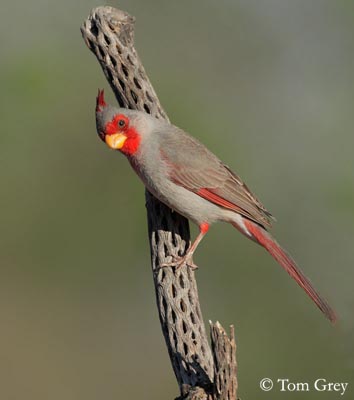
Pyrrhuloxia
Cardinalis sinuatus
Passeriforme Order – Cardinalidae Family
BIOMETRICS:
Length : 21 cm
Weight : 24-43 g
LONGEVITY: Up to 9 years
DESCRIPTION:
Pyrrhuloxia is a large, crested finch, permanent resident in its range.
Fr: Cardinal pyrrhuloxia
All : Schmalschnabelkardinal
Esp : Cardenal Desértico
Ital : Cardinale rosa
Nd : Grijze Kardinaal
Russe : Попугайный кардинал
Sd : Ökenkardinal
Photographs by Tom Grey
His website: Tom Grey's Bird Pictures
Photographs by Tom Merigan
His website: Tom Merigan’s Photo Galleries
Text by Nicole Bouglouan
Sources:
A GUIDE TO THE BIRDS OF MEXICO AND NORTHERN CENTRAL AMERICA by Steve N. G. Howell, Sophie Webb - Oxford University Press - ISBN: 0198540124
FIELD GUIDE TO THE BIRDS OF NORTH AMERICA - National Geographic Society - ISBN: 0792274512
All About Birds (Cornell Lab of Ornithology)
Animal Diversity Web (University of Michigan Museum of Zoology)
What Bird-The ultimate Bird Guide (Mitchell Waite)
Wikipedia (Wikipedia, The Free Encyclopedia)

Adult male in all plumages is greyish-brown to brownish grey. Wings and tail are slightly darker. Primaries and alula are red edged. Tail shows pinkish-red coverts.
Underparts are pale grey, with red medial stripe, from chin to belly, and some red wash in other parts.
Head is grey with thin pointed crest which is tipped red. Face shows red forehead, lores, eye ring and malar area.
Thick bill is “parrot-like”. It is yellow to horn and darker in winter. Upper mandible is decurved. Eyes are dark brown. Legs and feet are grey to dull flesh.
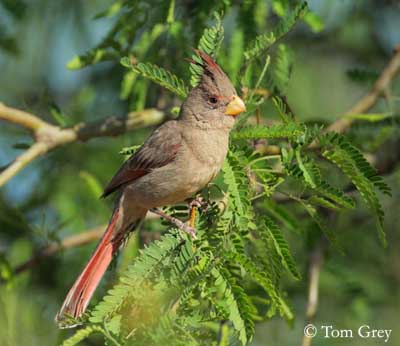
Female is slightly browner than male on head and upperparts. Crest is slightly red tipped, and she has reddish eye ring. Throat and underparts are pale greyish washed buff, and we can see pinkish wash on throat and chest. Bill is duller than in male and greyish in winter.
Juvenile resembles female but with grey bill and little or no red tipped crest.
Similar species: Northern Cardinal – Cardinalis cardinalis. Females of both species are very similar.
VOICE: SOUNDS BY XENO-CANTO
Pyrrhuloxia’s song is a variable series of notes at different pitches and intervals. It is a loud whistle, repeated 3 to 6 times or more “wheet-wheet…” or “whee-t-wee-twee…”
Pyrrhuloxia’s calls are usually a single note or series of the same note. We can hear a sharp “pik”, a bright metallic “plik” or “think”.
Songs may vary according to the location. Male sings frequently, but female is rarely heard, except in nest defence.
Both sexes use a high, chattering call “tic-tic-tic-tic…” in territorial disputes, as alarm or contact calls.
HABITAT:
Pyrrhuloxia is resident in arid to semi-arid scrub, thorny brush, cultivated areas with hedgerows, residential areas near mesquite grasslands and along stream beds.
RANGE:
Pyrrhuloxia is resident from SE Arizona to the Gulf Coast of Texas, and southwards to Central Mexico.
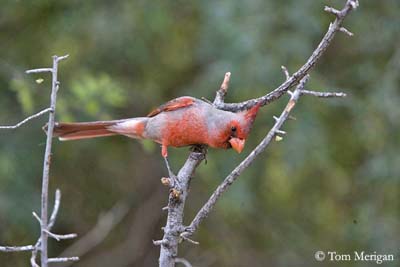
BEHAVIOUR:
Pyrrhuloxia feeds by foraging on the ground and in vegetation, searching for seeds, large insects and fruits. It may also glean insects from trees and shrubs, and catch large insects in flight. When food resources are abundant, flocks monopolise the source. It probably feeds also on nectar and pollen by dipping the head into Saguaro Cacti’s blossoms. It also frequents feeders, waiting for its turn in nearby tree. These birds forage in large flocks of hundreds of birds in winter. Pyrrhuloxia uses its strong bill to crack open and crush seeds.
During establishment of territory, Pyrrhuloxia pairs chase other birds with flatten crest. Males may have physical contact, and chase each other in flight. During aerial pursuit, two males can dart and dive until they catch each other, and then, they tumble to the ground, separating at the last moment. Male can also use aggressive posturing in territories, such as raising crest, spreading wings and tail, puffing out body feathers and calling. After a moment, one takes off and the other pursues it. Territoriality is less pronounced outside of breeding season.
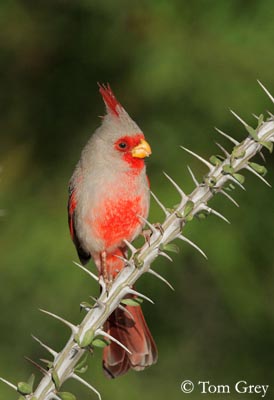
Pyrrhuloxia is probably monogamous. During courtship displays, male brings food to female. When female enters territory of unmated male, territorial and adjacent males call, perch close to her raising their crests, wings spread downwards and spread tail. Males can also follow female in flight, uttering some “fluttering” sounds with their wings. In addition to these displays, male bows its head, looking up at female, and then, it rises.
During breeding season, pair travel together and forage side by side, exchanging soft calls. In some areas, pair bonds may persist year-round, and others break down after nesting period.
In response to predators, Pyrrhuloxia reacts vocally from nearby perch. Pair may hop excitedly from branch to branch while calling loudly.
FLIGHT:
Pyrrhuloxia has undulating flight, with a few wing beats and glides. It flies short distances, about 60 metres.
REPRODUCTION:
Pyrrhuloxia’s nest may be situated in dense brush, hedgerow, mainly in Mesquite, but also in other plant species.
Nest is placed on small twigs, well away from trunk and main branches. It is at about 2,50 metres above the ground, sometimes higher. It is built by female, while male is singing far back in tree.
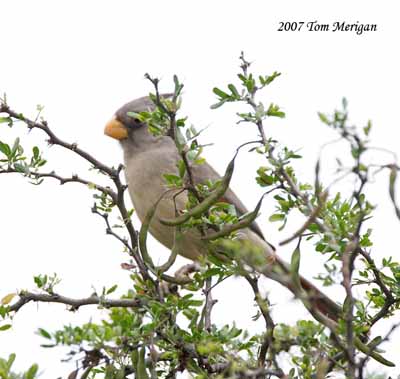
Nest is a small compact cup made with thorny twigs, strips of bark and coarse grass. Interior is lined with rootlets mainly on bottom, and horsehair, small plant stems and fibres. It is not attached to branches.
Female lays 2 to 3 greyish white eggs, speckled grey and brown. Incubation lasts about 14 days, by female. She is fed by male. Chicks are fed by both parents, and they leave the nest at about 10 days of age.
This species produces one brood per year.
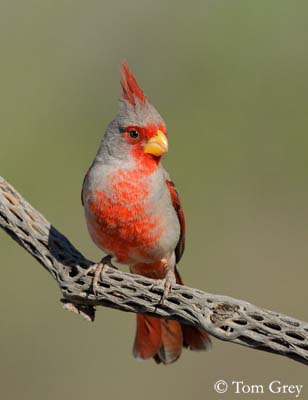
DIET:
Pyrrhuloxia feeds on seeds, fruits of cactus and insects such as grasshoppers, caterpillars, beetles…
PROTECTION/THREATS/ STATUS:
Pyrrhuloxia populations have declined, due to habitat loss in SW of United States. Monoculture reduces their habitat. However, preservation of suitable habitat within natural parks and reserves benefits this species. But birds may be killed by cats.